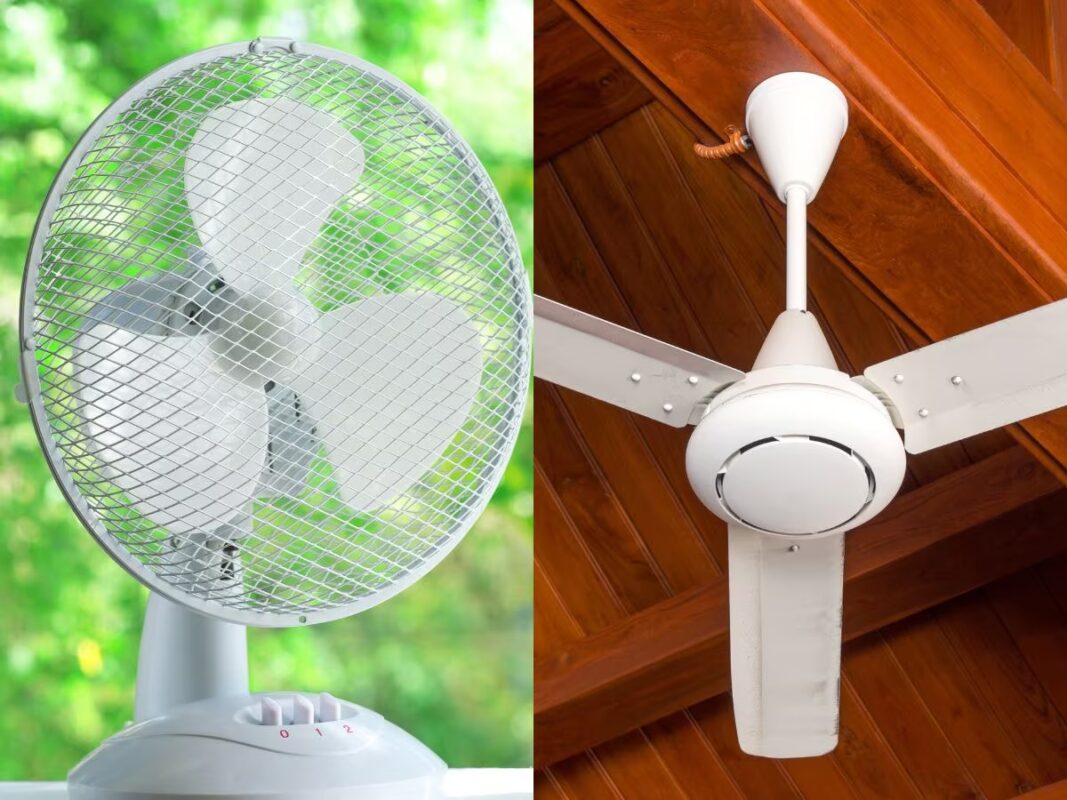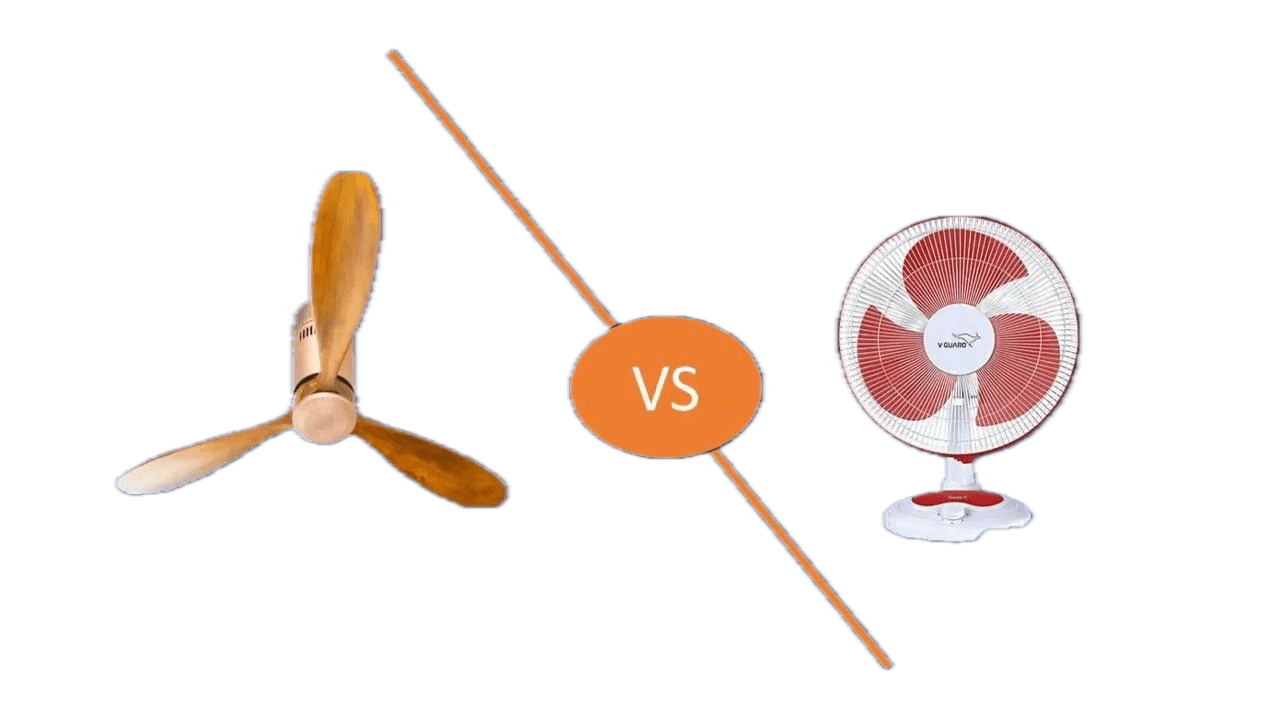Differences Between Table Fans and Ceiling Fans: Making the Right Choice
When it comes to beating the heat, both table fans and ceiling fans are popular choices. But which one suits your needs better? In this article, we’ll delve into the key aspects of table fans and ceiling fans to help you make an informed decision. Whether you’re a homeowner looking to upgrade your cooling solutions or a business owner seeking the best air circulation, read on to discover the pros and cons of both options.Table of Contents
| Sr# | Headings |
|---|---|
| 1 | Introduction |
| 2 | Table Fans: Your Portable Breeze Buddy |
| 3 | Ceiling Fans: The Grandmasters of Circulation |
| 4 | Air Distribution and Coverage |
| 5 | Energy Efficiency: Who’s the Saver? |
| 6 | Installation and Placement Tips |
| 7 | Aesthetic Appeal: Blending with Décor |
| 8 | Noise Levels: The Decibel Dilemma |
| 9 | Cost Considerations: Budget-Friendly Choices |
| 10 | Environmental Impact: Going Green |
| 11 | Maintenance and Cleaning: Ease of Care |
| 12 | FAQs: Your Top Questions Answered |
| 13 | Conclusion: The Perfect Fan for You |
1. Introduction
As the mercury rises, finding the right cooling solution becomes paramount. In this guide, we’ll navigate the features and benefits of table fans and ceiling fans, aiding you in the quest for the ideal fan to keep your space comfortable.2. Table Fans: Your Portable Breeze Buddy
Table fans, also known as desk fans, are your personal breeze companions. These compact fans are designed to sit on tables, desks, or countertops, providing direct airflow to a specific area. Need to cool down while working on your laptop? A table fan’s gentle breeze has got you covered.3. Ceiling Fans: The Grandmasters of Circulation
Ceiling fans are the true stalwarts of air circulation. Mounted on the ceiling, these fans effectively distribute air throughout the room. They excel at maintaining consistent air movement, making them a popular choice for bedrooms, living rooms, and even outdoor spaces like patios.4. Air Distribution and Coverage
Table fans offer localized cooling, focusing their airflow on a small area. In contrast, ceiling fans cover larger spaces by circulating air from above, creating a more widespread and balanced cooling effect.5. Energy Efficiency: Who’s the Saver?
When it comes to energy efficiency, ceiling fans take the lead. They consume significantly less energy than air conditioners, making them an eco-friendly and cost-effective cooling solution. Table fans are also energy-efficient but are better suited for personal cooling.6. Installation and Placement Tips
Installing a table fan is a breeze – simply plug it in and turn it on. Ceiling fans require more complex installation and are best left to professionals. Table fans are versatile and can be moved around as needed, whereas ceiling fans become a fixed fixture.7. Aesthetic Appeal: Blending with Décor
Ceiling fans seamlessly blend with room décor, as they hang from the ceiling and don’t take up floor or table space. On the other hand, table fans come in various designs and colors, allowing you to choose one that complements your style.8. Noise Levels: The Decibel Dilemma
Table fans are generally quieter compared to ceiling fans. If you’re sensitive to noise or need a fan in a quiet workspace, a table fan might be your best bet. Ceiling fans, while not overly noisy, do produce more sound due to their larger size.9. Cost Considerations: Budget-Friendly Choices
Table fans are usually more affordable upfront, making them an attractive option for those on a budget. Ceiling fans have a higher initial cost due to installation expenses. However, their energy efficiency helps offset this cost in the long run.10. Environmental Impact: Going Green
Both table fans and ceiling fans are environmentally friendly compared to air conditioners. However, ceiling fans have a slight edge due to their lower energy consumption. By opting for fans, you’re reducing your carbon footprint.11. Maintenance and Cleaning: Ease of Care
Maintaining a table fan involves simple tasks like wiping the blades and cleaning the grill. Ceiling fans require occasional dusting and might need a ladder for higher reach. Table fans win in terms of easy maintenance.FAQs: Your Top Questions Answered
Q1: Can I use a table fan as the primary cooling source in a room? A1: While table fans are great for personal cooling, they might not suffice for larger rooms. Consider ceiling fans for more effective air circulation.Q2: Do ceiling fans lower room temperature like air conditioners? A2: No, ceiling fans don’t lower the room temperature. They create a cooling effect by circulating air, making you feel more comfortable.Q3: Can I install a ceiling fan on my own? A3: Ceiling fan installation can be complex due to electrical work. It’s best to hire a professional for safe and proper installation.Q4: Are table fans noisy? A4: Table fans are generally quieter than ceiling fans, making them suitable for bedrooms, offices, and quieter spaces.Q5: Which fan option is more cost-effective in the long run? A5: Ceiling fans are more cost-effective in the long run due to their energy efficiency and lower operational costs.Conclusion: The Perfect Fan for You
In the end, the choice between a table fan and a ceiling fan boils down to your specific needs. If you’re seeking personalized cooling at a lower cost, a table fan is your go-to. However, for efficient room-wide circulation with an eco-friendly touch, a ceiling fan is the winner. Consider your space, preferences, and budget to make the right cooling investment.- Product on sale
 Sonashi Tower Fan with 25 Feet Air Delivery, 4-Way Air Flow Anti Dust 5 Blade Tower FanOriginal price was: ₹4,200.00.₹2,989.00Current price is: ₹2,989.00.
Sonashi Tower Fan with 25 Feet Air Delivery, 4-Way Air Flow Anti Dust 5 Blade Tower FanOriginal price was: ₹4,200.00.₹2,989.00Current price is: ₹2,989.00. - Product on sale
 Jyoti Portable Revolving & Oscillating 1 Blade Tower FanOriginal price was: ₹4,280.00.₹2,789.00Current price is: ₹2,789.00.
Jyoti Portable Revolving & Oscillating 1 Blade Tower FanOriginal price was: ₹4,280.00.₹2,789.00Current price is: ₹2,789.00. - Product on sale
 Havells 1320mm Florette BLDC Motor Ceiling Fan | Remote Controlled, High Air Delivery Fan | 5 Star Rated, Upto 60% Energy Saving, 2 Year Warranty | (Pack of 1, Smoke Brown Wood)Original price was: ₹18,975.00.₹11,399.00Current price is: ₹11,399.00.
Havells 1320mm Florette BLDC Motor Ceiling Fan | Remote Controlled, High Air Delivery Fan | 5 Star Rated, Upto 60% Energy Saving, 2 Year Warranty | (Pack of 1, Smoke Brown Wood)Original price was: ₹18,975.00.₹11,399.00Current price is: ₹11,399.00. - Product on sale
 Havells 1200mm Elio BLDC Motor Ceiling Fan | Remote Controlled, High Air Delivery Fan | 5 Star Rated, Upto 60% Energy Saving, 2 Year Warranty | (Pack of 1, Smoke Brown)Original price was: ₹6,530.00.₹4,033.00Current price is: ₹4,033.00.
Havells 1200mm Elio BLDC Motor Ceiling Fan | Remote Controlled, High Air Delivery Fan | 5 Star Rated, Upto 60% Energy Saving, 2 Year Warranty | (Pack of 1, Smoke Brown)Original price was: ₹6,530.00.₹4,033.00Current price is: ₹4,033.00. - Product on sale
 Havells 1200mm Elio BLDC Motor Ceiling Fan | Remote Controlled, High Air Delivery Fan | 5 Star Rated, Upto 60% Energy Saving, 2 Year Warranty | (Pack of 1, Brown)Original price was: ₹5,630.00.₹4,033.00Current price is: ₹4,033.00.
Havells 1200mm Elio BLDC Motor Ceiling Fan | Remote Controlled, High Air Delivery Fan | 5 Star Rated, Upto 60% Energy Saving, 2 Year Warranty | (Pack of 1, Brown)Original price was: ₹5,630.00.₹4,033.00Current price is: ₹4,033.00. - Product on sale
 Havells 1200mm Elio BLDC Motor Ceiling Fan | Remote Controlled, High Air Delivery Fan | 5 Star Rated, Upto 60% Energy Saving, 2 Year Warranty | (Pack of 1, Grey)Original price was: ₹6,530.00.₹4,544.00Current price is: ₹4,544.00.
Havells 1200mm Elio BLDC Motor Ceiling Fan | Remote Controlled, High Air Delivery Fan | 5 Star Rated, Upto 60% Energy Saving, 2 Year Warranty | (Pack of 1, Grey)Original price was: ₹6,530.00.₹4,544.00Current price is: ₹4,544.00. - Product on sale
 Havells 1200mm Efficiencia Prime BLDC Motor Ceiling Fan | 5 Star with Remote, 100% Copper | Upto 53% Energy Saving, High Air Delivery, 2 Year Warranty, Inverter Friendly, Timer | (Pack of 1, Bianco)Original price was: ₹5,210.00.₹3,222.00Current price is: ₹3,222.00.
Havells 1200mm Efficiencia Prime BLDC Motor Ceiling Fan | 5 Star with Remote, 100% Copper | Upto 53% Energy Saving, High Air Delivery, 2 Year Warranty, Inverter Friendly, Timer | (Pack of 1, Bianco)Original price was: ₹5,210.00.₹3,222.00Current price is: ₹3,222.00. - Product on sale
 Havells 1200mm Efficiencia Prime BLDC Motor Ceiling Fan | 5 Star with Remote, 100% Copper | Upto 53% Energy Saving, High Air Delivery, 2 Year Warranty, Inverter Friendly, Timer | (Pack of 1, Brown)Original price was: ₹4,000.00.₹3,222.00Current price is: ₹3,222.00.
Havells 1200mm Efficiencia Prime BLDC Motor Ceiling Fan | 5 Star with Remote, 100% Copper | Upto 53% Energy Saving, High Air Delivery, 2 Year Warranty, Inverter Friendly, Timer | (Pack of 1, Brown)Original price was: ₹4,000.00.₹3,222.00Current price is: ₹3,222.00. - Product on sale
 Havells 1200mm Efficiencia Prime BLDC Motor Ceiling Fan | 5 Star with Remote, 100% Copper | Upto 53% Energy Saving, High Air Delivery, 2 Year Warranty, Inverter Friendly, Timer | (Pack of 1, White)Original price was: ₹5,395.00.₹3,099.00Current price is: ₹3,099.00.
Havells 1200mm Efficiencia Prime BLDC Motor Ceiling Fan | 5 Star with Remote, 100% Copper | Upto 53% Energy Saving, High Air Delivery, 2 Year Warranty, Inverter Friendly, Timer | (Pack of 1, White)Original price was: ₹5,395.00.₹3,099.00Current price is: ₹3,099.00.
























